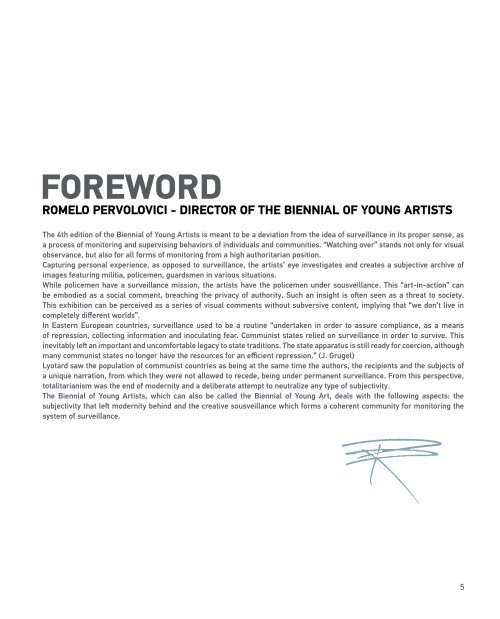Catalogue Police the police
Catalogue Police the police
Catalogue Police the police
Create successful ePaper yourself
Turn your PDF publications into a flip-book with our unique Google optimized e-Paper software.
FOREWORD<br />
ROMELO PERVOLOVICI - DIRECTOR OF THE BIENNIAL OF YOUNG ARTISTS<br />
The 4th edition of <strong>the</strong> Biennial of Young Artists is meant to be a deviation from <strong>the</strong> idea of surveillance in its proper sense, as<br />
a process of monitoring and supervising behaviors of individuals and communities. “Watching over” stands not only for visual<br />
observance, but also for all forms of monitoring from a high authoritarian position.<br />
Capturing personal experience, as opposed to surveillance, <strong>the</strong> artists’ eye investigates and creates a subjective archive of<br />
images featuring militia, <strong>police</strong>men, guardsmen in various situations.<br />
While <strong>police</strong>men have a surveillance mission, <strong>the</strong> artists have <strong>the</strong> <strong>police</strong>men under sousveillance. This “art-in-action” can<br />
be embodied as a social comment, breaching <strong>the</strong> privacy of authority. Such an insight is often seen as a threat to society.<br />
This exhibition can be perceived as a series of visual comments without subversive content, implying that “we don’t live in<br />
completely different worlds”.<br />
In Eastern European countries, surveillance used to be a routine “undertaken in order to assure compliance, as a means<br />
of repression, collecting information and inoculating fear. Communist states relied on surveillance in order to survive. This<br />
inevitably left an important and uncomfortable legacy to state traditions. The state apparatus is still ready for coercion, although<br />
many communist states no longer have <strong>the</strong> resources for an efficient repression.” (J. Grugel)<br />
Lyotard saw <strong>the</strong> population of communist countries as being at <strong>the</strong> same time <strong>the</strong> authors, <strong>the</strong> recipients and <strong>the</strong> subjects of<br />
a unique narration, from which <strong>the</strong>y were not allowed to recede, being under permanent surveillance. From this perspective,<br />
totalitarianism was <strong>the</strong> end of modernity and a deliberate attempt to neutralize any type of subjectivity.<br />
The Biennial of Young Artists, which can also be called <strong>the</strong> Biennial of Young Art, deals with <strong>the</strong> following aspects: <strong>the</strong><br />
subjectivity that left modernity behind and <strong>the</strong> creative sousveillance which forms a coherent community for monitoring <strong>the</strong><br />
system of surveillance.<br />
5


